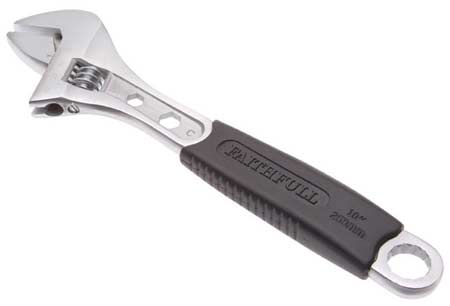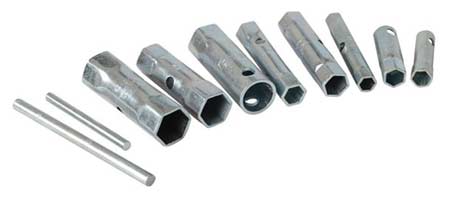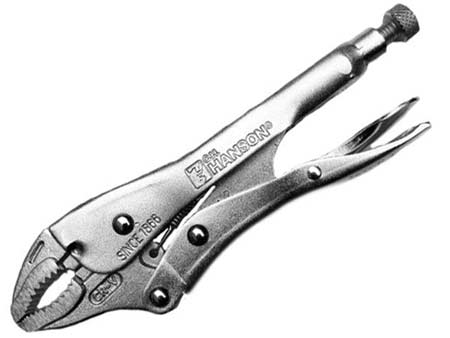There are numerous types of spanners and wrenches for a variety of different uses. Spanners are known as wrenches in North America – we will use UK English when describing spanners and wrenches in this project on the whole.
A spanner or wrench is used for turning a nut, bolt or similar fixing that is turned to tighten. The spanner is used to grip the given fixing (whether it is a nut, bolt, concrete screw etc….) and turn it, allowing you to apply torque and tighten the nut onto the bolt.
They are generally made from drop forged steel and coated in chrome to stop corrosion. Higher quality spanners tend to be made from Chromium-Vanadium alloys and in some cases even tutanium.

Parts of an Adjustable Spanner

The Parts of a Pipe Wrench or Stillson Wrench
Spanner Sizes
The size of the spanner refers to the size of the nut or bolt that will fit into the jaws. They are either measured in Metric (millimeters) or Imperial measurement (inches or thousandths of an inch).
Interestingly before around 1920 the measurement was made to the diameter of the threaded part of the nut rather than the outside of the nut. This is not something that we have seen ourselves, but we found this image on Wikipedia. It’s pretty obvious why that measurement system didn’t last long!

The old fashioned and modern way of measuring a spanner size – Image courtesy of Wikipedia

Old and new spanners compared together for size
Types of spanner and wrench:
Spanners
These tend to come in one of three types of spanner:
- Open ended spanners are the most popular spanners for both DIY and Motoring jobs. They have an open ″C″ into which the nut fits
- Ring Spanners are the spanners which hold the nut with a ring
- Combination Spanners have a ring at one end and are open ended at the other end
A set of any of these types of spanner are usually inexpensive but very useful and a must for any tool box.

Combination spanner set
Socket Set
A socket set is a great way to have a collection of tools for tackling nuts and bolts. They are a great replacement for a spanner set and can be more compact and easier to carry around. They do tend to be a little more expensive and sometimes hard to use in awkward to reach places.
Socket sets generally come with a ratchet, which is a big help and will save a lot of time as it avoids the need to constantly take a spanner off of a nut or bolt ready for the next turn. The more expensive they are the more sockets and fittings that you will get, but it is possible to get a socket set relatively cheaply that will cover pretty much every domestic situation.

Socket set
Adjustable Spanners
Adjustable spanners can be used to fit a wide range of screws and bolts so save you having to carry around a wide range of different sized spanners. The issue is that they can be tricky to use as they might not lock tight onto the nut or bolt.
Aside from this small drawback they are very handy to have in the tool box for one good reason – More often than not you may only have one of each size spanner and when it comes to un-doing or doing up a nut or bolt they are great for holding bolt heads while you tighten the nut with a spanner.

Adjustable spanners and wrenches
Ratchet Spanners
Ratchet spanners are spanners that are a great labour saving device but they do cost a little more. There will always be a place in the DIY sheds and motoring stores for the ratchet spanner which allows you to undo a nut without taking the spanner off, kind of like a hybrid of a spanner and socket and ratchet.

Ratchet spanner sets
Basin Spanners and Basin Wrenches
A basin spanner is a bespoke spanner for undoing the nuts and back nuts holding taps onto basins and baths. They come in two common types; the basin wrench and the tap wrench with a T bar which is often used for finer and harder to reach tap nuts under basins and baths. They are both relatively cheap, but will save a lot of effort.

Cast iron basin wrench

Adjustable basin or tap wrench
Box Spanners
Commonly made of steel tube, the box spanner is typically used for removing spark plugs. They normally feature a six-sided ring-type head that fits the nut that has been pressed out of the steel tube during the manufacturing process. They are turned using a T-bar passed through the two holes in the middle.

Box spanner sets
Pipe Wrench or Stillson Wrench
Pipe wrenches are for large and heavy jobs. They are also known as Stillson wrenches or Stillsons. The beauty of using Stillson is the sheer strength of the grip the teeth on the jaws allow. As you have no doubt guessed they are used for pipe work, where the diameter of the fixing is typically larger than common nuts and bolts and the torque needed for tightening and un-doing is much greater also.

Pipe Wrench’s are commonly referred to as a Stillson Wrench’s
Immersion Heater Spanner
An immersion heater spanner is an invaluable tool for a plumber. It has a large ring that is designed to fit around the element in a water heater. There are two main types of immersion spanner; ring headed and box spanners. (the one pictured here is the box head type).

Box head immersion spanner
Mole Grips
While these are not really a spanner or wrench in the traditional sense, they are commonly used for the same purpose. They are useful for holding bolts still while you work on loosening the nut. They are for more lightweight tasks, although the larger more expensive mole grips can be relatively sturdy.

Mole grips or locking pliers
Strap Wrenches
A strap wrench is used to hold pipes and other objects with a larger diameter. They are useful for objects that do not have a grip for a spanner or wrench to get a hold on. They are also useful because they can apply a relatively large amount of torque without marking the object. They are used in plumbing and motor mechanics typically.

A strap wrench in action
Over the last 10 years DIY Doctor has been asked to test spanners, wrenches, socket sets, ring spanners, box spanners, bulldogs, Stillsons, Mole Grips and strap wrenches and any number of adjustable spanners.
The most important factor about any spanner of wrench albeit an adjustable spanner or pipe wrench is to be able to fit it or adjust it to the exact size of the nut. The very act of turning the spanner puts a strain on the adjustment thread and this "stretches" the opening. Result? The spanner slips off and either rounds off the end of the nut or breaks your knuckles ……………Sometimes both.
If you get the right spanner (or wrench) the chances of this happening are much less. Get the right tool for the job!

